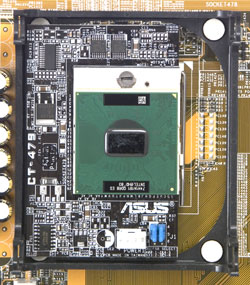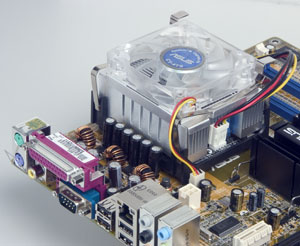 |
||
|
||
| ||
We already reviewed Intel Pentium M performance on the desktop platform not long ago. The only news since then is the official announcement of Pentium M 780 2.26 GHz. It's quite a commonplace event and performance of this processor it predictable: it's no different from the previous Pentium M 760/770 processors, but for its clock. But as this CPU found its way to our lab, we decided to test its performance anyway. At least because there are not so many Pentium M tests on the desktop platform on our web site :). But this time we decided to focus only on the maximum performance possible. So we carried out our tests only on a motherboard based on the i915 chipset with an adapter from ASUS (this configuration is described in detail in the previous article on a similar topic).  The adapter with a processor installed into Socket 478 on a motherboard.  The same components with an installed cooler (it's a special cooler that comes shipped with the bundle of this adapter) Thus, Pentium M 780 + i915 demonstrates the maximum performance we can squeeze from an Intel mobile processor on a desktop without overclocking. Besides, as Pentium M 780 is faster than the 770 model, we decided to add another two processors to Athlon 64 3700+ and Pentium 4 540 — Athlon 64 4000+ and Pentium 4 560. They are to mark the upper limit, that is to show what "truly desktop" processors cannot be outperformed by the mobile solution from Intel so far, even on a desktop motherboard with dual-channel memory. Testbed configurations
Test resultsRemember that diagrams with all test results (61 items!) are published on a separate page — without comments, just as is. The article provides only summary diagrams that calculate the results of entire test groups into average scores. This approach appeases curiosity of the most inquisitive readers, who are against cutting down the number of test results published in our articles, and still makes the article less motley and graphics-intense. What concerns our comments, real professionals (who are interested in details) are expected to need none of them. SPECapc for 3ds max 6 (3ds max 7.0)Pentium M features almost a linear performance growth, which proves that the 533-MHz bus is still sufficient at such frequencies. As always, Pentium 4 does not look very good in this test due to a serious defeat in the Interactive sub-test (see detailed results). Symptomatically, Pentium M fairs very well in this very sub-test as well as Athlon 64 — it means that their architectures are similar in terms of preferences of the program. That's understandable: both of them have a short pipeline. SPECapc for Maya 6 (Maya 6.5)And here the Athlon 64 stands off, the main fight is between Intel processors, Pentium M 780 being the fastest. Proceeding from this result, we can draw an interesting conclusion about the test itself: as the CPU with the lowest memory bus throughput managed to win, it would be logical to assume that SPECapc for Maya is indifferent to this parameter. On the other hand, Pentium M has the largest L2 Cache. Let's consider we have found an answer... Lightwave 8.2, renderingPentium 4 560 turns out the best processor at rendering, the 540 model also acts well, having been outperformed only by the Athlon 64 4000+. In our opinion, Pentium 4 owes its good results to virtual multi-processing support — Hyper-Threading, as Lightwave supports multi-threading. Pentium M performance scales well with the clock, but there is nothing unusual about it for this task: render engines are usually indifferent to memory bandwidth. SPECapc for SolidWorks 2003Quite a predictable result for those who have read the previous article. Adobe Photoshop CS (8)Pentium 4 processors are the best here (probably again due to Hyper-Threading), Pentium M 780 is in between Athlon 64 3700+ and 4000+ in terms of performance. The "steps" of Pentium M processors is absolutely even, which proves their excellent scalability, at least within the reviewed clock range. Adobe Acrobat 6.0All-purpose data compression (archiving)It's probably the only class of applications that shows memory bandwidth dependence. Pentium M still scales evenly — but the step size is much lower. Multimedia lossy compression (MP3/MPEG2-4)There is no point in commenting on the average score, but we'd like you to pay your attention to the detailed results. You can see well that AMD processors (traditionally) "failed" the LAME encoding test (Q=0 option). But these are general results, not as interesting as "drops" of the Pentium M. The latter didn't do well in MPEG4 / Windows Media Video sub-test and utterly failed the MPEG2 / Canopus ProCoder sub-test. As they say: "for your information..." CPU RightMark 2004BPentium 4 processors set the fashion due to their Hyper-Threading support and good optimization of the CPU RightMark render engine to multi-processing. 3D games and graphics visualization
|
The short-pipeline Pentium M crushes the Pentium 4 in games, but it still cannot compete with the Athlon 64. Quite unassuming step size in the line Pentium M 760 —> 770 —> 780 speaks of an important role played by the memory bandwidth in this class of software.
The difference between our participants is beggarly here, which hints at an insufficiently powerful video card.
On the one hand, Pentium M 780 is not that bad. In most cases it fairs rather well against the fast desktop processors from Intel and AMD. On the other hand, let's not forget that we compare the fastest Pentium M processor with non-top desktop CPUs. In addition to Athlon 64 4000+, AMD offers Athlon 64 FX-55/57; Pentium 4 560 is outperformed at least by Pentium 4 570, to say nothing of the 660/670 and eXtreme Edition 3.73 GHz. So: "Not bad indeed, but nothing more". Of course, the Pentium M has its own trump cards — low heating, low power consumption. However, in the first place, users require performance from their desktops (why else you need a desktop?) If you take into account that building a desktop with a top Pentium M processor may be even more expensive than the same system on Athlon 64 FX-57, we can only establish a fact that desktop computers on Pentium M will most likely remain an interesting toy for "quiet PC" fans and other IT aesthetes. There is nothing good or bad about it, it's just a fact...
Write a comment below. No registration needed!
|
Article navigation: |
| Most Popular Reviews | More RSS |
 |
Comparing old, cheap solutions from AMD with new, budget offerings from Intel.
February 1, 2013 · Processor Roundups |
 |
Inno3D GeForce GTX 670 iChill, Inno3D GeForce GTX 660 Ti Graphics Cards A couple of mid-range adapters with original cooling systems.
January 30, 2013 · Video cards: NVIDIA GPUs |
 |
Creative Sound Blaster X-Fi Surround 5.1 An external X-Fi solution in tests.
September 9, 2008 · Sound Cards |
 |
The first worthwhile Piledriver CPU.
September 11, 2012 · Processors: AMD |
 |
Consumed Power, Energy Consumption: Ivy Bridge vs. Sandy Bridge Trying out the new method.
September 18, 2012 · Processors: Intel |
| Latest Reviews | More RSS |
 |
Retested all graphics cards with the new drivers.
Oct 18, 2013 · 3Digests
|
 |
Added new benchmarks: BioShock Infinite and Metro: Last Light.
Sep 06, 2013 · 3Digests
|
 |
Added the test results of NVIDIA GeForce GTX 760 and AMD Radeon HD 7730.
Aug 05, 2013 · 3Digests
|
 |
Gainward GeForce GTX 650 Ti BOOST 2GB Golden Sample Graphics Card An excellent hybrid of GeForce GTX 650 Ti and GeForce GTX 660.
Jun 24, 2013 · Video cards: NVIDIA GPUs
|
 |
Added the test results of NVIDIA GeForce GTX 770/780.
Jun 03, 2013 · 3Digests
|
| Latest News | More RSS |
Platform · Video · Multimedia · Mobile · Other || About us & Privacy policy · Twitter · Facebook
Copyright © Byrds Research & Publishing, Ltd., 1997–2011. All rights reserved.